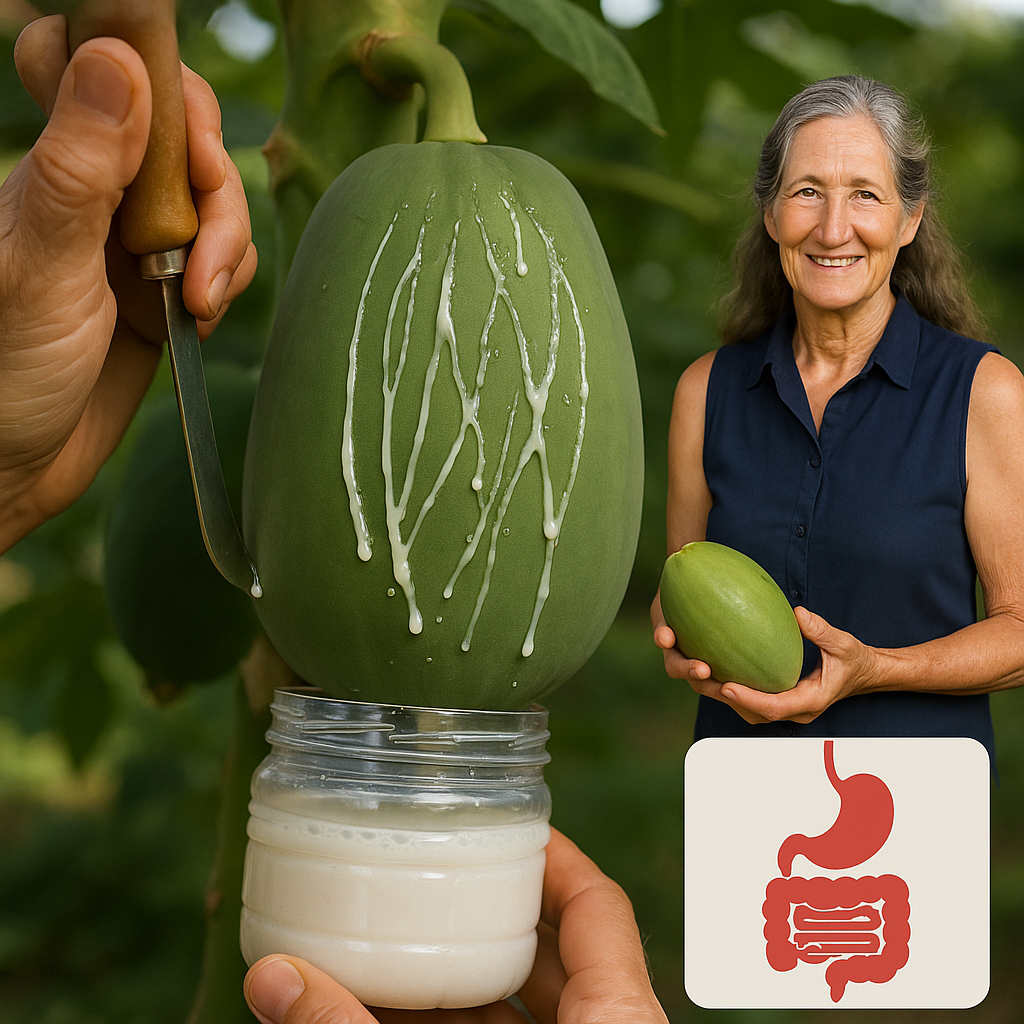When it comes to natural healing, few plants offer as much untapped potential as the papaya—and we’re not just talking about the fruit. Hidden within its stems, leaves, and unripe fruit is a milky white substance called papaya sap, also known as latex. Often overlooked, this sap is a biological goldmine filled with powerful enzymes, particularly papain, which has been used for centuries in traditional medicine.
Whether you’re looking for a natural digestive aid, skin treatment, or anti-inflammatory remedy, papaya sap offers a multi-purpose solution straight from nature. Here’s everything you need to know about this potent plant-based elixir—and how to safely use it at home.

What Is Papaya Sap?
Papaya sap is a milky latex extracted from the green fruit, stems, or leaves of the Carica papaya plant. Its key active compound, papain, is a type of proteolytic enzyme that helps break down proteins in the body. The sap also contains chymopapain, flavonoids, alkaloids, and vitamins A, C, and E, all of which contribute to its healing effects.
Used topically or internally in small amounts, papaya sap supports a wide range of health goals—from digestion to immune protection to skincare.
10 Powerful Benefits of Papaya Sap
1. Supports Healthy Digestion
Papain helps break down tough proteins in the stomach, aiding digestion and reducing bloating, gas, and constipation. This enzyme makes papaya sap a valuable natural remedy for people with sluggish digestion or those recovering from heavy meals.
2. Reduces Inflammation Naturally
Both papain and chymopapain exhibit anti-inflammatory properties. When applied topically or used internally in small doses, papaya sap may help ease pain and swelling from arthritis, sprains, and joint discomfort.
3. Accelerates Wound Healing
Due to its antimicrobial and proteolytic effects, papaya sap has long been used to promote faster healing of cuts, burns, and scrapes. It helps clean wounds, prevent infection, and stimulate skin regeneration.
4. Improves Skin Appearance
Papaya sap acts as a natural exfoliator, removing dead skin cells and unclogging pores. It’s particularly effective against acne, scars, pigmentation, and uneven skin tone. Over time, regular use can enhance skin clarity and glow.
5. Helps Eliminate Intestinal Parasites
In traditional herbal medicine, papaya sap has been used to expel intestinal worms and parasites, thanks to its enzyme-driven ability to disrupt their reproductive cycles. It’s commonly used as part of natural detox regimens.
6. Strengthens the Immune System
The antioxidants and enzymes in papaya sap help reduce oxidative stress and enhance immune response. The sap supports white blood cell activity, making it useful during periods of illness or immune suppression.
7. May Inhibit Abnormal Cell Growth
Some preliminary studies suggest papaya sap may help prevent abnormal cell proliferation, making it a subject of interest in natural cancer-prevention research. While it’s not a cure or substitute for medical treatment, it shows potential for future applications.
8. Offers Natural Pain Relief
When applied to insect bites, sore muscles, or minor burns, papaya sap provides soothing pain relief. It may act similarly to topical analgesics by calming inflammation and improving blood flow to the area.
9. Promotes Heart Health
By reducing inflammation and supporting healthy cholesterol metabolism, papaya sap contributes to cardiovascular wellness. Its antioxidant activity may also help protect blood vessels from oxidative damage.
10. Removes Warts and Skin Growths
The enzymes in papaya sap break down keratin, a key protein in warts and moles. With regular topical application, it can help dissolve these skin growths gently over time—no harsh chemicals required.

How to Use Papaya Sap in Everyday Life
1. For Skincare
- Acne & Dark Spots: Apply a thin layer of fresh sap to affected areas. Leave on for 10–15 minutes before rinsing.
- Warts & Moles: Dab a small amount directly onto the wart daily. Be consistent, and avoid applying to healthy skin.
- Exfoliation: Mix a drop of sap with aloe vera gel for a gentle face mask that clears dead skin and evens tone.
2. For Wound Care
Apply papaya sap directly to minor cuts or burns after cleaning the area. It acts as a natural disinfectant and encourages faster tissue repair.
3. For Digestion
- Mix 2–3 drops of sap into a glass of warm water or herbal tea before meals.
- Use sparingly, especially for the first time, as the sap is potent and can cause irritation if overused.
4. As a Meat Tenderizer
Rub papaya sap on raw meat and let it sit for 15–30 minutes before cooking. The enzymes break down tough fibers, resulting in tender, easier-to-digest meat.
5. For Pain and Swelling
- Soak a cloth in a water-and-sap mixture and apply it as a compress to inflamed joints or sore muscles.
- Repeat as needed for relief from aches or arthritis.
6. For Natural Pest Control
Mix papaya sap with water and spray around plants or garden areas to repel insects and pests. Its natural toxicity to many soft-bodied insects makes it an eco-friendly option.
Safety Tips and Precautions
While papaya sap offers many benefits, it’s important to use it responsibly.
- Patch test before use: Apply a small amount to your skin and wait 24 hours to check for reactions.
- Avoid open wounds: Do not apply sap to deep or bleeding wounds.
- Use sparingly: A few drops go a long way. Too much can cause irritation, especially on sensitive skin or in the digestive tract.
- Store properly: Keep fresh sap in an airtight container in the refrigerator. Use within a few days.
- Consult your doctor: Especially if pregnant, nursing, or taking medications. Papaya sap may interfere with certain treatments or conditions.

What the Science Says
Scientific research highlights the role of papain and chymopapain in reducing inflammation, supporting digestion, and breaking down dead tissue. These enzymes are so effective that they’ve been isolated for use in pharmaceuticals and wound debridement therapies.
In addition to enzymes, papaya sap contains flavonoids, alkaloids, and trace minerals that contribute to its healing effects. Its antioxidant profile also makes it a valuable ally in reducing free radical damage.
Final Thoughts: Should You Add Papaya Sap to Your Routine?
Papaya sap may not be as famous as its sweet fruit, but its benefits are vast, time-tested, and deeply rooted in traditional wellness. From skin care to digestive support, pain relief to parasite cleansing, it offers a natural and versatile alternative to many over-the-counter solutions.
By learning how to use it correctly and safely, you can unlock the powerful healing potential hidden inside every papaya plant. Whether you grow your own or buy from a trusted source, adding a few drops of papaya sap to your routine could be the small natural upgrade your health regimen has been waiting for.
Would you like a visual guide, printable recipe sheet, or product infographic to share online or publish on your site?





